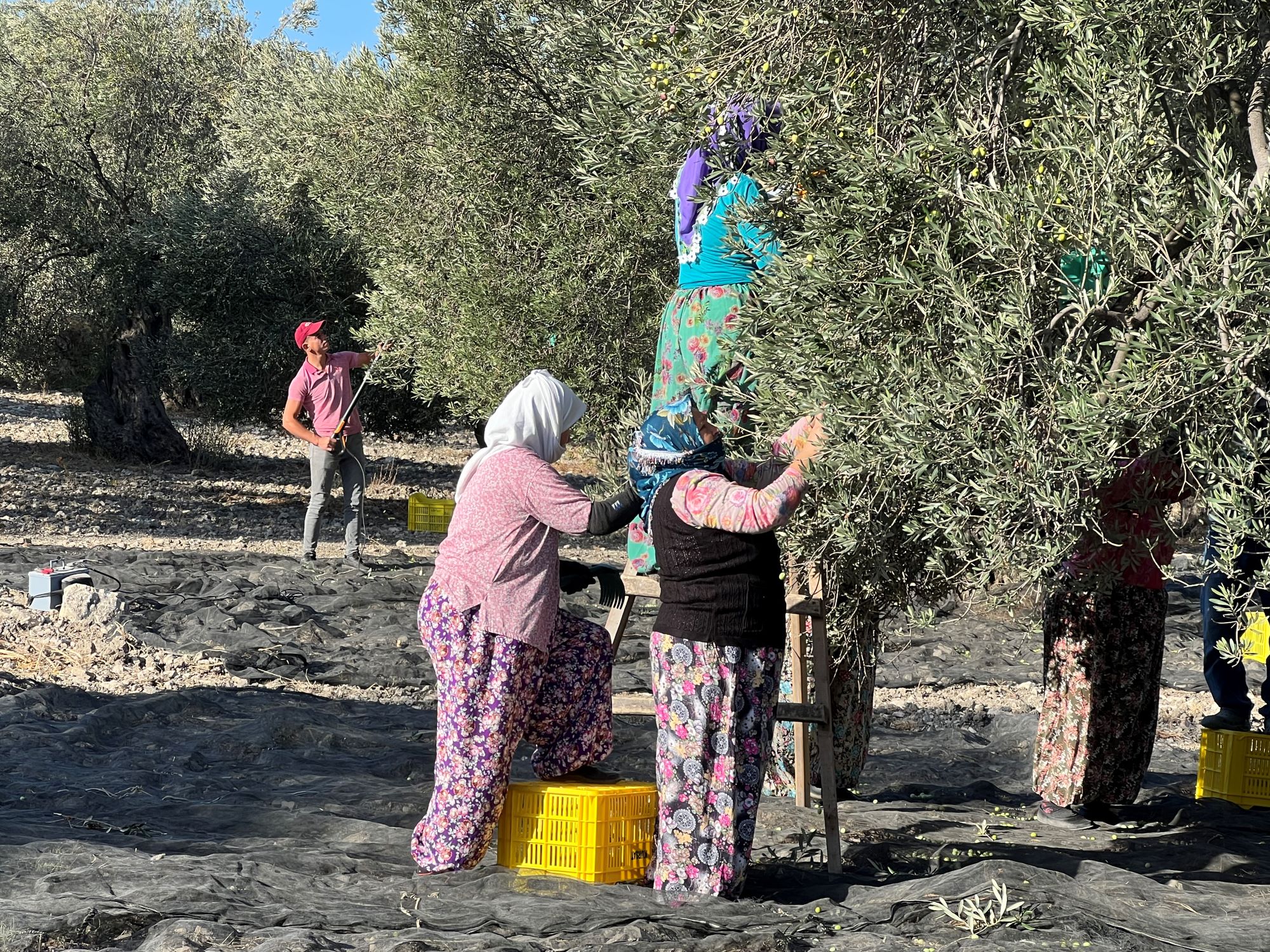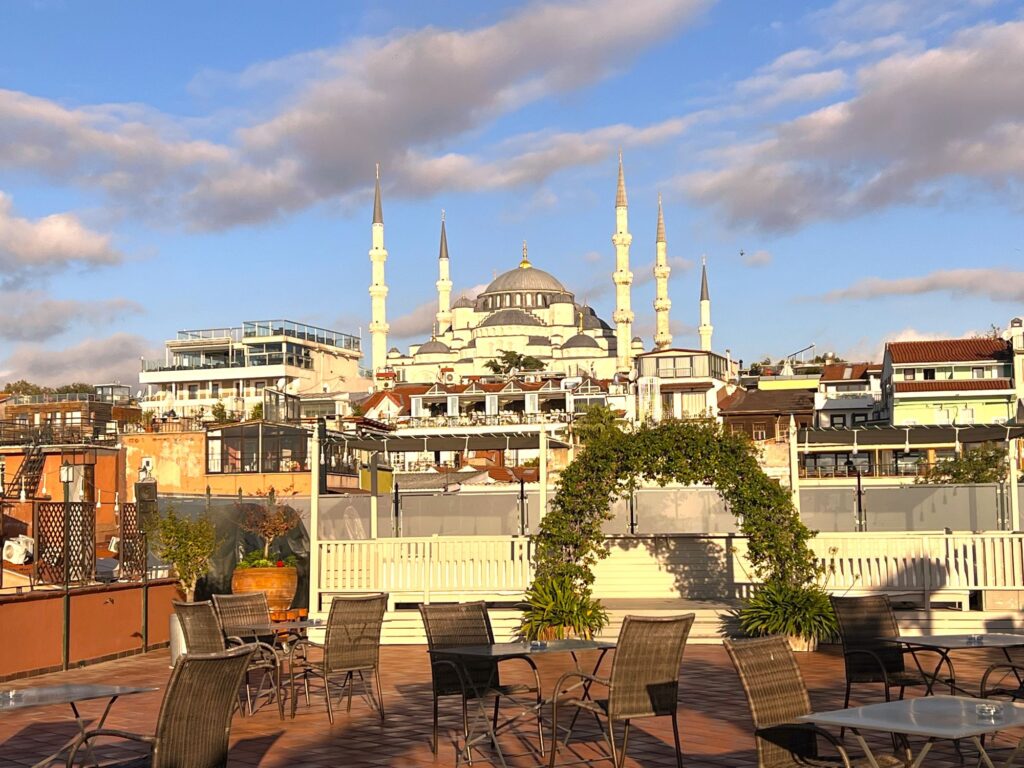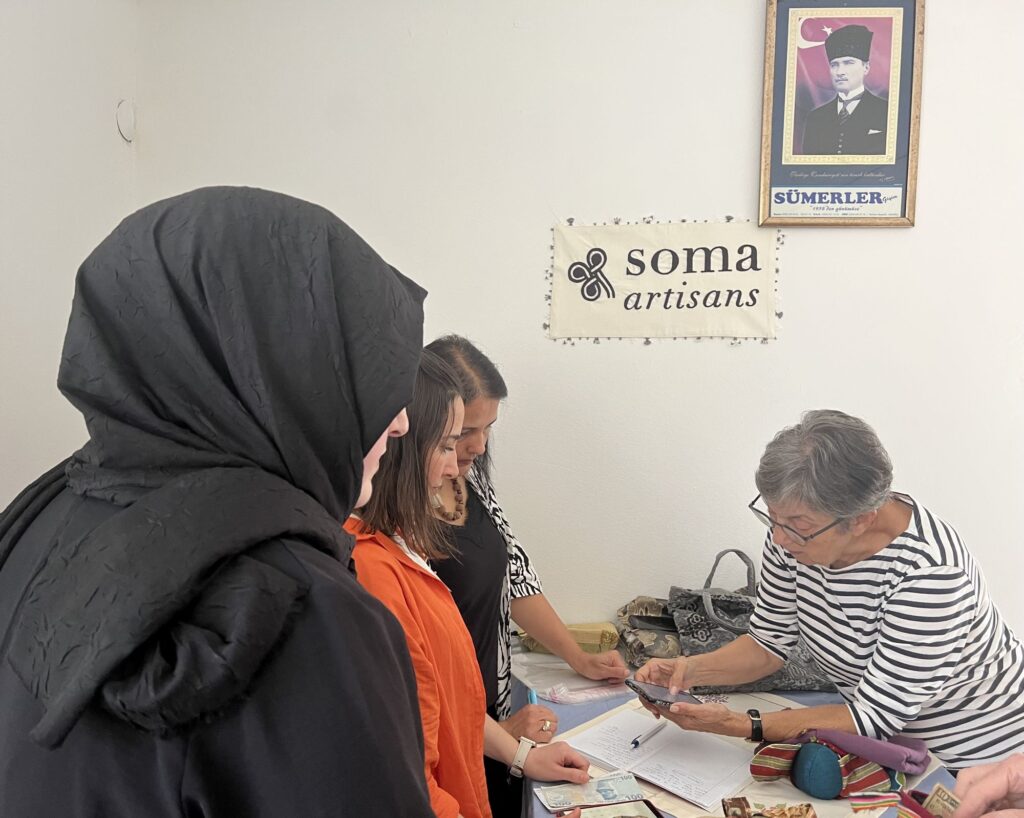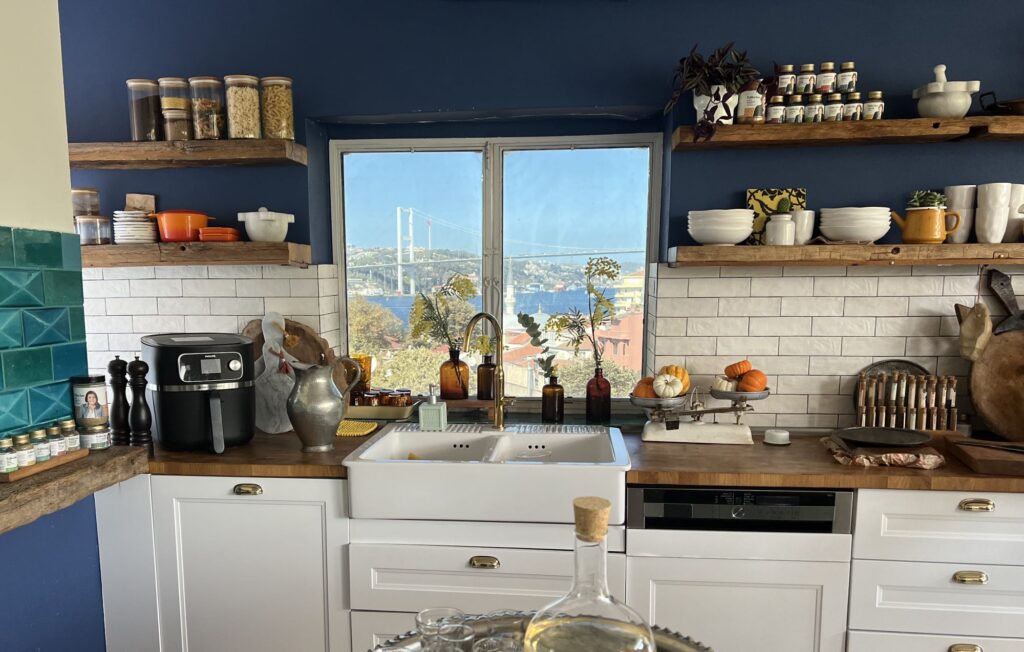Chef Semsa Denizsel has been called the “Alice Waters of Turkey” because she shares the same farm-to-table sensibilities and, like Waters, is passionate about teaching them. Even at her former Istanbul restaurant Kantin, which was celebrated for simple but sophisticated food, she ventured to farmers markets and talked to growers to expand sourcing and enliven flavors from traditional ingredients such as parsley, mint and dill herbs.
Semsa, an animated redhead, who is also a food writer, food blogger and food guide, reinvented herself at her olive farm about five hours southwest of Istanbul on the Aegean Sea, where she opened the Cooks Grove teaching kitchen outside Ayvalik to create food events for visitors and teach others how to select and prepare locally sourced ingredients. A colleague of our food guide for the entire tour, Hulya Eksigil, an Istanbul journalist, Semsa is highly regarded outside the region. The week before we arrived, Ana Sortun, the Boston area’s acclaimed Turkish chef and James Beard Foundation awardee, took a group to Semsa’s teaching kitchen. She calls the Northern Aegean cuisine in which geography informs gastronomy “TurkAegean” and talks about it in this YouTube video.
Midway during our culinary tour of Turkey that was sponsored by Anatolian Artisans, our adventuresome group of Womantravelers took that trip by bus from Istanbul to the Northern Aegean region where silvery olive trees blanket the low rolling hills in all directions. Ayvalik is a picturesque seaport and getaway that anchors the region famous for olive oil, cheeses, fresh green herbs and seafood and retains many beautiful and beneficial features of its violent history as a crossroads of Turkish and Greek cultures. Besides our adventures with Semsa, we tasted many flavors of this lively seaport, including Turkish tahini helva, the sweet confection made from a base of sesame tahini, roasted and garnished with walnuts, almonds or cocoa. (Location: Tiflipasa, a 10th generation tahini, helva and Turkish delight specialist since 1775).
After settling in our charming boutique hotel, Elia Otel on Cunda Island across the causeway from the main part of Ayvalik, we changed for a glorious festive dinner under the stars at Cooks Grove outside town. If you’ve been to a wine dinner in Napa Valley vineyards, you can visualize the setting – a crisp cool evening warmed by (olive) wood-burning fires and sheltered by a dark black sky and umbrella of sparkling stars. We were surrounded by olive groves.
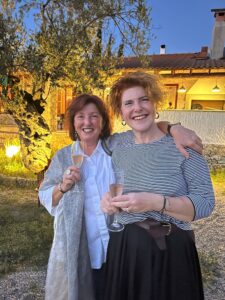 The welcome reception started with a sparkling rose wine from Turkey and cracked green olives from the farm. We were swept into an elegant evening guided by her enthusiasm for food and customized by a carefully curated menu of signature Turkish dishes emboldened with bright fresh herbs and other “Semsa” flourishes. Her delightful stories about each dish reflected her commitment to finding and using “always the best ingredients and not a single one, industrially produced.”
The welcome reception started with a sparkling rose wine from Turkey and cracked green olives from the farm. We were swept into an elegant evening guided by her enthusiasm for food and customized by a carefully curated menu of signature Turkish dishes emboldened with bright fresh herbs and other “Semsa” flourishes. Her delightful stories about each dish reflected her commitment to finding and using “always the best ingredients and not a single one, industrially produced.”
“Sharing the food, sharing the table…it’s so important and we don’t do it enough anymore,” Semsa said, as the dishes were passed. Imagine the flavors (and these are only a few) – young cheese with fresh oregano and garlic, end of season figs and cress, hummus with oil, pickled and marinated greens, baby calamari with fresh thyme and “tons of” olive oil, mincemeat dumplings, zucchini fritters, rice pilaf (juiced by a reduction of slowly cooked baby goat, sliced onion, garlic and eggplant) and red wine from the Gallipoli Peninsula. “Olive trees are always magical,” said Semsa of dining in the olive groves. “They take my breath away.”
SIX Experiences in One
In our nearly two days curated by Semsa, our group of Womantravelers had six “experiences.”
First, the memorable dinner described above.
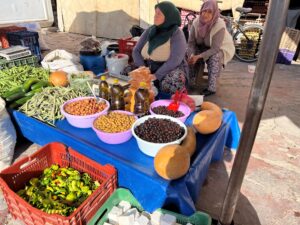 Next came a morning at the regional farmers market in Ayvalik, where Semsa sources her provisions and we did some shopping for our hands-on cooking lesson, strolling among the expansive selections from small producers from family farms and large firms. There is nothing like learning about local food and culture from someone like Semsa, who lives and works in that environment every day.
Next came a morning at the regional farmers market in Ayvalik, where Semsa sources her provisions and we did some shopping for our hands-on cooking lesson, strolling among the expansive selections from small producers from family farms and large firms. There is nothing like learning about local food and culture from someone like Semsa, who lives and works in that environment every day.
The farmers showcased large and plump fruits and vegetables, enormous piles of fresh fish (sardines, bonito, sea trout, sea bream, anchovies), tall stacks of local cheeses and bins and bins of many varieties of beans and nuts. You wonder who could possibly eat all that fresh food before it spoils.
That evening, for our third related outing, we dined downtown at Sofia Ayvalik, a top-rated upscale restaurant in an old stone building with tables outside in a narrow alley. The Aegean-focused ingredients chosen for us by the Istanbul-trained female chef was sophisticated country fare – with meats, vegetables and several varieties of offal (internal organs) in keeping with the tradition of using the entire animal in country cooking. Frankly I was a bit wary, but course after course of delicious food converted me. We started with lamb head cheese with lemon and pilaf with prunes and pistachios; next came pickled beef tongue, fried local cheese with roasted eggplant and walnuts and a lamb stew with lettuce and leek. The finish was a dessert of tangerine chocolate mousse. To die for, yes???
For our fourth, fifth and sixth experiences, we started the next morning by picking olives at Semsa’s farm.
As novice olive pickers, our determined group of Womantravelers, ranging in age from mothers of school-age children to over 80, was energetic and made a respectable contribution to the buckets and buckets picked as well by the experienced daily field workers (both men and women). Our host was Ali, whose family business operates these groves and produces olives and olive oils respecting traditions going back generations. He explained an olive tree takes a minimum of seven years to start producing olives. After three years of bounty, each tree is finished and new trees planted. He estimates there are about 20,000 trees in these groves.
The day’s harvest begins after large nets are placed on the ground to catch the green olives. Workers use their bare hands and “rakes” to strip the branches of the stone fruit; they climb up ladders and across limbs to ensure all the olives are removed. We watched them, then did our share (except for the tree climbing). It was hot, and our hats, the shade and ample supplies of water were most welcome. Harvest season lasts about three months, with each field finished in three weeks.
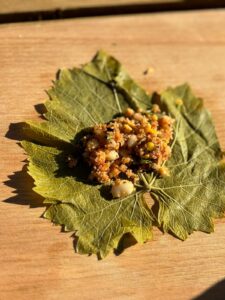 From the field, we moved to a clearing that served as an outdoor teaching kitchen and had three lessons – in preparing cracked green olives and dolmas and in properly tasting olive oils.
From the field, we moved to a clearing that served as an outdoor teaching kitchen and had three lessons – in preparing cracked green olives and dolmas and in properly tasting olive oils.
We took our places standing around a long table; we each had denim aprons, towels to wipe our hands as we moved through our chores, small cutting boards and paring knives.
For the cracked olives, Ali demonstrated the technique – to cut a shallow slit in the just-picked green olive’s skin lengthwise and plunge the olive in a jar of water, where it soaks for weeks and loses its bitterness (the water is changed about once a week). As a rule, the jars are refrigerated for three months before serving. I’ve tasted many types of olives, but because of their crisp pungency, cracked green olives have quickly become my favorite, especially as appetizers or snacks.
Semsa led the lesson in making “dolmas,” which means “stuffing” or “filling.” Many delicious varieties are popular in Greek and other Mediterranean cuisines as well. On our boards in front of us, we placed a spoonful of a premade mixture of bulghur wheat, parboiled beans, parsley, basil, dried mint, yellow lentils and “tons” of black pepper onto a large young grape leave and watched her demonstrate how to fold in the sides so that the stuffing didn’t spill out. As a professional chef, Semsa was exacting, and if we were a bit sloppy, she gently directed us to start over to get it right. Our dolmas were covered with a thick sauce prepared earlier by Semsa and her team from rack of baby goat, garlic, onion, sumac water and tomatoes. This “casserole” style dish heated in the outdoor wood-fired oven for an hour or so before lunch was served.
The olive oil tasting provided artful insights into a technique requiring a lot of practice. 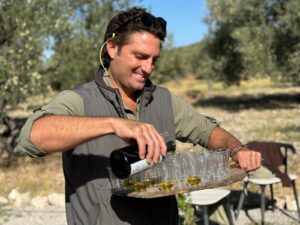 “Wine is man made,” Ali told us, “but nature makes olive oil. Our job is to facilitate the best it can be.” His family is a major regional producer and distributor of olives and olive oils, preserving sustainable farming methods, rather than the mass-produced “industrial” practices that lead to most “extra virgin olive oils” found on grocery shelves.
“Wine is man made,” Ali told us, “but nature makes olive oil. Our job is to facilitate the best it can be.” His family is a major regional producer and distributor of olives and olive oils, preserving sustainable farming methods, rather than the mass-produced “industrial” practices that lead to most “extra virgin olive oils” found on grocery shelves.
Ali’s expertise taught us how to identify an oil’s intrinsic characteristics. First you warm up your hands; you sniff deeply and at the same time take a small sip, so when the olive oil is swirling lightly around the inside of your mouth, you are both smelling and tasting at the same time – oh, yes, and with your lips slightly opened. It definitely takes some practice! The flavor may be fruity, pungent or bitter, or you may discover other sensory notes. Close my eyes and I could have been wine-tasting, a similar process perfected by repetition over time.
We learned, too, that once olive oil is pressed, it should be bottled as quickly as possible, be kept out of the sunlight and used within 5-6 weeks once opened. If you can’t do that, then distribute the larger quantity into smaller bottles that you can use in that timeframe.
Were we hungry by now? You bet! Our genuine “farm to table” meal was ready on the covered porches of Cooks Grove. We started with a green salad dressed with cucumbers, homemade harvest bread with new olive oil, fresh tomatoes drenched with olive oil, fresh green olives with lots of salt and pepper and, of course, the dolmas in their sauce, highlighted with a chilled natural rose wine.
After all our work and education at Cooks Grove, in these moments I truly understood the meaning of “bliss!”
Semsa must have agreed that we were a fun bunch. She captured these days in a Facebook reel – and summed it up this way: “We had these wonderful moments, sharing everything harvesting olives, tasting new oil, rolling dolmas, firing up ovens, early mornings and sunsets, the chill of the evening and the warmth of the autumn sun cheering with drinks and wonderful food.”
You can follow Semsa’s Substack blog (in English) with cooking tips and recipes – “Semsa’s Food Per Se.”
Epilogue: Since we have returned, Semsa, a born and bred Istanbulite and lover of olives, has left Turkey for Thessalonki in the the Greek Aegean region. She spells out her reasons and the next steps in her culinary practice in her Substack blog. Largely they largely revolve around Turkish politics and the current regime’s moves to sell land on which the olive groves grow (and support 70 percent of the regional economy), for its ever-expanding construction projects.
